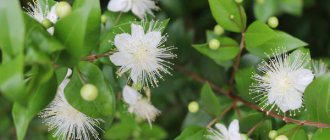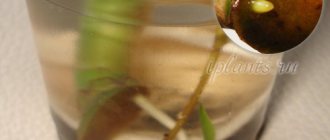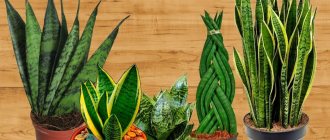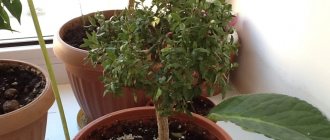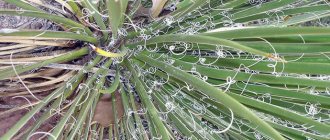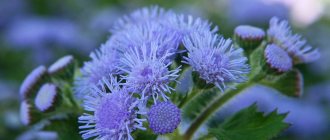Myrtle is a plant for those who love peace, comfort and tranquility. Myrtle is an evergreen shrub or tree that belongs to the Myrtaceae family, which has about one hundred species. Myrtle is native to the Mediterranean and grows naturally in tropical and subtropical climate zones. In Crimea, the Caucasus, and on the Black Sea coast, myrtle is grown in open ground as an ornamental plant. In a greenhouse it grows up to 2 meters, but when grown in a pot it is modest in size. Myrtle leaves are small, glossy, ovoid, arranged oppositely.
The trunk is woody and branches well. Myrtle blooms are small, single, fragrant white flowers. They appear in the axils of the leaves, rising on a long peduncle. Blooms from early summer. Pollinate indoor myrtle using a brush. In autumn, pollinated plants bear fruit - juicy, spicy dark blue berries appear. Seeds from the fruit can be used for propagation.
By providing proper care for the plant, myrtle will delight you with its decorative effect throughout the year. Unpretentious, can live with you for a long time. It lends itself well to pruning, which allows you to form a beautiful crown in the form of a pyramid, ball and other shapes.
The history of the origin of the myrtle flower
The history of the origin of the evergreen plant goes back to distant, ancient times. Who would have thought that this modest, unremarkable flower, according to legend, was with Adam when God expelled him from paradise. According to long-standing belief, the first man took myrtle with him to Earth from the Garden of Eden of Bliss. He decided that it would remind him on sinful earth of the wonderful life in Paradise. This is often why ancient people revered myrtle as a symbol of hope for a bright future.
Emblem of joy and sadness
In other sources, the birthplace of this flower was Persia. The legend says that the plant was brought by the Persians from Egypt. During the burial of the pharaohs, myrtle branches were carried by mourners. And Swedish, German and English princesses wove it into their hair or into their wedding bouquets. It symbolized strong love in marriage. Queen Victoria introduced this tradition during her reign. This tradition has been preserved to this day among the British.
Among the ancient Jews, myrtle was a symbol of peace and heaven. They also decorated the deceased with myrtle wreaths.
Greek goddesses and myrtle
The Greeks also respected myrtle. They considered it a reminder of the bad deeds that the goddess Minerva had done. One day the goddess decided to compete in a race with the nymph Myrsina and lost the argument to her. Minerva became angry with her favorite and killed her in anger. When the goddess realized what a terrible crime she had committed, the goddess began to beg the other gods to leave her some kind of memory of the nymph. The gods took pity on the goddess. A beautiful tree sprouted from the girl’s body, which later became known as myrtle. According to another legend, Venus wore a wreath made from this plant, which attracted the attention of King Paris.
Signs associated with the plant
It is believed that healing myrtle is a symbol of prosperity and a successful, happy marriage, which is why this plant often became a desired wedding gift. In ancient times, brides' heads were even decorated with its branches. If a myrtle tree has already been given to a married couple, then such a gesture is perceived as a wish to strengthen understanding and love in the home. There is also a belief that it is the myrtle tree that can give eternal youth and beauty. And even if the presence of myrtle in the house does not bring unfading youth, the owner is guaranteed a lot of pleasure from the beautiful appearance of the plant.
Botanical description of the plant
Myrtle is a plant belonging to the genus and family of the same name. Among its representatives (clove tree, guava, eucalyptus and others) there are many evergreen trees and shrubs, the plant mass of which contains essential oils. The homeland of the flower is considered to be the Mediterranean region, northern Africa and southern European countries.
In the wild, myrtle grows up to 4–5 meters; indoor specimens barely reach a meter. And that's not all. There are varieties that are true dwarfs. At home, myrtle is grown as a tree or bush. This plant is also well suited for bonsai formation. All representatives of the myrtle family are characterized by the following features:
- The leaves are leathery, elongated and pointed, with a shine, as if varnished. They are attached to the stems using short petioles. In dwarf varieties their length is several millimeters.
- The flowers are white, cream, pinkish, and can grow singly or in inflorescences. They can be simple or terry. Some species have many stamens on long stalks and the flowers resemble furballs.
- The fruits are berries with a dozen seeds. We should not confuse it with the “African myrtle”, or more precisely with the African myrtle, a plant from a different family, which after flowering produces purple berries with a single seed.
The plant looks great in any interior, which is why designers value it so much. Myrtle does not require particularly complicated care, and these graceful, delicate bushes bring a lot of benefits. The substances it releases are capable of destroying pathogenic microbes, purifying the air in the room. Therefore, myrtle is often placed in bedrooms and children's rooms. It can be found in offices and various offices. It is believed that the plant increases performance and also has a positive effect on the microclimate in the team.
The healing properties of myrtle have been known since ancient times. With its help, intestinal diseases and colds were treated, wounds were healed, and the skin was rejuvenated.
Modern research has proven the effectiveness of products prepared from this plant. Among other things, they are used to combat tumors, stimulate mental activity and strengthen the heart, and much more. The myrtle flower is used as additives and seasonings for various dishes. And its tonic, anti-inflammatory and soothing properties came in handy in the cosmetics industry.
Proper watering and fertilization
The myrtle tree should be watered with settled water at room temperature, without chlorine.
The frequency of watering depends on various factors: - temperature, air humidity and amount of light.
One of the main ones is the condition of the soil. It should not be completely dry. Excessive watering can cause roots to rot and leaves to fall off.
If the plant's leaves have drooped and faded, it is worth spraying it. A shower for myrtle is also necessary to combat pests and various diseases. You can moisten the tree by placing containers of water in close proximity to the plant. A humidifier will also make the task easier.
Myrtle requires fresh air, so the room in which it is located must be constantly ventilated. But at this moment the plant should be moved to another room so that it does not freeze.
The myrtle tree is fertilized, but it is done carefully. If you add humus to the soil when transplanting, then the next fertilizing can only be done in the summer. Usually the plant is fertilized in the spring with complex compounds, and after flowering - with nitrogen. Myrtle also accepts fertilizing in the form of spraying.
Caring for myrtle
The myrtle plant is unpretentious in care. Compact bushes and trees take up little space and are suitable for growing in even the smallest spaces. The main thing is to comply with a few simple conditions. And then Adam’s tree will grow for you for many years.
Soil for planting
The plant shows its non-conflict character even when choosing soils. Any substrate will do, as long as it is light and well-drained. You can pick up ready-made soil in a specialized store.
Experienced people who have grown more than one flower prefer to make the soil mixture themselves, adding the necessary ingredients to it. For example, you can take sand, turf soil, coal, vermicompost and coconut substrate in equal parts. A composition of peat, sand and humus is also suitable. But ordinary greenhouse soil also performs well. When planting myrtle in a pot, be sure to lay a drainage layer.
Lighting and temperature
Indoor myrtle loves bright, diffused light, so the best place for it would be window sills on the east and west sides of the house. If the flower is oriented to the south, then during especially hot hours in direct sunlight, the greenery of the myrtle should be slightly shaded. In summer, the plant is taken for a walk on the balcony or in the yard, also choosing a place where there will be no scorching sun.
Myrtle is a plant that was originally grown in greenhouses and winter gardens. Only then did the flower growers decide to move it into the rooms. In summer, the flower feels good at home even in the heat, you just need to increase watering and spraying.
In winter, it is useful to move the crop to a cooler place. Nothing will happen to him even at temperatures below 10 C. This could be a closed loggia, an insulated veranda or a winter garden. Such a cool winter will guarantee more active growth and lush flowering. If in winter you leave a flower, the same myrtle communis, in an ordinary room at room temperature, its leaves may fly off. But good care and moderate watering will return the plant to full development. True, there may not be any flowering this season.
Watering and air humidity
From spring to autumn during the growing season, the flower requires abundant watering. You need to wait until the top layer of soil in the pot dries, and only then water the plant. You shouldn’t create a real swamp inside either. In this case, the root system of the common myrtle will rot and the plant may die. To prevent this from happening, the pot must have drainage holes and a drainage layer that does not allow the liquid to stagnate. In winter, watering is reduced, but the soil should not be allowed to dry out completely. Water the flowers with settled water at room temperature.
Coming from the tropics, myrtle needs high air humidity. But many cultivated varieties are comfortable with the indoor microclimate. When caring for myrtle at home in hot weather, it would also be useful to spray the leaves of the flower. In winter, spraying is not carried out. For the procedure itself, it is advisable to take soft, settled water. Hard water needs to be softened, because over time it causes a white coating to appear on the soil and the leaves begin to turn yellow.
Feeding
From March to early September, myrtle needs additional care in the form of fertilizing. They are applied once every two weeks, some prefer to do it weekly. You can use a complex universal fertilizer for flowering plants with microelements, for example, Aquamarine, Mortar and others.
Indoor myrtle does not like calcium, so when purchasing fertilizers, make sure that it is not included.
Comments (8)
Angela
04/06/2018 at 00:18 |
I wanted to grow myrtle at home. I picked off a twig from a small tree in the store. The branch took root well and quickly began to grow. But the joy did not last long. After about 2 months, all the leaves fell off and my myrtle dried up.Answer
Yulia Expert Plodogorod
12/25/2018 at 00:01 |
Hello Angela! The first reason why myrtle could shed its leaves is that the temperature is too high for this flower, since it loves coolness. If during cold weather the plant stands on a windowsill under which there are radiators, then they should be covered or the flower should be moved. In spring and summer the temperature should not exceed 20 degrees, and in winter and autumn 10.
Another probable cause of leaf falling is overdried soil or excess moisture. Therefore, this plant needs to be watered regularly, but only when the top layer of soil is completely dry. In winter, watering is less frequent. Lack of lighting leads to the same consequence. It is better to diffuse sunlight. Myrtle does not tolerate direct sunlight for long.
If the plant eventually died, then most likely it was attacked by a spider mite. Their appearance is indicated by thin cobwebs and white dots on the back of the leaves. The appearance of this pest is often provoked by dry air. Therefore, regularly spray and even occasionally bathe your pets in the shower. Moreover, it is myrtle that loves these procedures. But don’t overdo it, otherwise prevention will lead to rotting. You need to make sure that there is no moisture left in the axils of the leaves.
Among folk remedies to combat this pest, it is often recommended to wash the flower with laundry soap or dishwashing detergent. This will not solve the problem, but it will reduce the number of mites. Do not leave the flower in the soap solution for a long time, this will cause a chemical burn.
Among chemical substances, preparations of acaricides and insectoacaricides are usually used. Please note that the treatment must be carried out several times in order to destroy the eggs of spider mites. Otherwise, the whole struggle may be in vain.
There are also complex action tablets that are inserted into the soil. They both fertilize and protect indoor plants from pests. Usually a new tablet is placed in the pot once a month.
Answer
masmetall
04/30/2018 at 01:21 |
I read somewhere that it is very good to have this plant in the house. I went straight into the store and inquired about availability - it wasn’t there then. Yes, I somehow forgot, and then again I came across an article about the usefulness of the flower. I need to buy it, apparently.
Answer
Yulia Expert Plodogorod
11/26/2019 at 01:01 |
Hello masmetall! You are absolutely right, the described plant is very useful to keep in the house. Thanks to various substances and oils in the crown, myrtle is able to cleanse the indoor atmosphere from bacteria and infection.
It is believed that simply being in the same room with the culture has a positive effect on the treatment of colds, as well as various problems with the respiratory tract. According to some sources, the phytoncides contained in such a plant even kill the causative agents of tuberculosis.
According to European traditions, along with the described culture, peace comes to the family and romantic attraction increases. For this reason, myrtle is often included in wedding bouquets. But the same belief says that the death of a plant promises various troubles, so it is important to carefully care for such a home flower.
In Greek culture, the described flower is considered a symbol of beauty and youth. Previously, in this country, infusions for washing were prepared from myrtle, as well as drinks that were considered an elixir of health.
It is recommended to grow myrtle only at home. This plant is not suitable for office premises or other public places.
Answer
Christina
12/23/2018 at 02:13 pm |
My mother has been growing two myrtles for a long time. A friend gave her a small shoot, now my mother has two large trees, as tall as the entire window. Moreover, she doesn’t make any special efforts to care for her. Apparently, they just like the climate in their apartment near Moscow. Windows face east, temperature (except in summer) is low, heat is poor)))
Answer
Yulia Expert Plodogorod
26.11.2019 at 01:36 |
Hello, Christina! In this case, one of the significant positive factors is the lack of intensive heating in winter. The fact is that this plant is characterized by a period of rest. For it to proceed correctly, a decrease in temperature is necessary.
At such times, it is better for the temperature to be within 9-10 degrees. A decrease of even up to 5 degrees is possible. If the winter is warm, various diseases and leaf fall are possible. After all, the natural cycle of cultural development is disrupted.
On southern and western windows, the dormant period lasts about six weeks. The northern windows increase the duration of the specified period to three months. This is how long it takes to maintain the specified temperature readings.
In addition, in winter almost all plants suffer from batteries and radiators. After all, dry air negatively affects their development, the appearance of the crown can deteriorate, immunity decreases, and spider mites often appear.
Therefore, if in cold times the heating is quite strong and the radiators are hot, it is better to put the flowers away from them. But even in this case, we recommend using a stationary humidifier or placing a container of water near the plants.
We would like to note that dry air is harmful not only to plants, but also to people. This can cause headaches and respiratory discomfort. Therefore, measures to humidify the air will be useful to all inhabitants of the house.
If you decide to use the option with a container filled with water, it is important to ensure that the moisture is clean and does not have an unpleasant odor. Otherwise, such a measure will, on the contrary, saturate the atmosphere with bacteria.
If there is nowhere to move the flowers away from the battery, then it is better to cover it with a thick cloth so that the leaves do not get burned. You can slightly moisten the fabric. Then you can at the same time slightly humidify the air in the room.
Although this plant loves spraying and bathing in the summer, it is better to refrain from this in winter so as not to provoke the development of fungus. The described passive methods of air humidification are sufficient.
Answer
Sergey Zudin
25.11.2019 at 19:35 |
My wife brought myrtle shoots from work several times, but for some reason they did not take root. The neighbor said that there is not enough light in our apartment. Is she right and maybe we should turn on the light bulbs at night?
Answer
Yulia Expert Plodogorod
26.11.2019 at 02:30 |
Hello, Sergey Zudin! Myrtle does need good lighting, but without direct sunlight. This means that western and eastern windows are suitable for such a culture. Then the plant will show itself in all its decorative potential.
If you cultivate myrtle plants on a north window, there may be a lack of flowering, elongated shoots and pale foliage. But it is death from lack of light that is doubtful. Unless in the described case, the myrtle was located in a room without windows or in the far corner of the room, far from the light source.
Additional lighting is required only if the indoor flower suffers from insufficient lighting. In addition to the elongation of the crown and its pale tint, falling leaves and a sickly appearance in general can indicate a lack of sun. If you decide to use additional lighting sources, you need to purchase a special phytolamp. Only then will such events be effective.
In addition, it is absolutely not worth using additional lighting all night. The plant has a certain rhythm of life. During the day and night, different processes take place - the production of oxygen and its absorption. If the natural order of things is disrupted, the culture will begin to suffer and lose its decorativeness.
Most likely, the cuttings were improperly planted or the rules of planting and rooting were violated. This plant will take root if propagated by cuttings in January and mid-summer. Materials must be semi-lignified. The optimal size is 6-7 cm. Some of the leaves should be removed.
To increase the chances of rooting, we recommend using a root formation stimulator. But, it is important to note that such a remedy can contribute to the rotting of the cuttings. To protect the future plant from this, it is important to disinfect the substrate before planting. For example, it will be fried in the oven.
Perhaps the moisture regime is not maintained, or the soil is too dense, which does not provide sufficient oxygen access to the roots of the plant. After planting, it is important to create greenhouse conditions by wrapping the plant in a film or bag. In this case, the shelter should have several small holes for ventilation. Every day you need to ventilate the plants to ensure that mold does not appear on the surface of the soil.
It may take 3-4 weeks for myrtle to take root.
Answer
Transplanting myrtle
Young plants can be replanted annually. Although myrtle is characterized by slow growth, the root system increases and requires more and more space. Older specimens can live in one pot for 2–3 years without replanting.
The reasons for transplantation may also be the following:
- Purchasing a plant in a store where it was in a shipping pot.
- The appearance of insect pests in the soil and on the flower itself.
- Plant disease.
We choose a new place of residence for the flower from November to March. At this time, the common myrtle is dormant, and replanting will not have any unpleasant effects on the plant. We select a new container slightly larger than the previous one.
After purchasing the plant, you need to give it some time to adapt, and then be sure to transplant it into a new pot and new substrate. Both the shipping container and the land in it are designed for only a short period of sales. Therefore, for a new planting, we select a universal soil for flowers or create our own soil mixture.
When replanting, first remove the plant with the entire earthen lump. Pre-watering is not necessary. We hold the myrtle flower by the base of the stem, turn it down and carefully remove it from the pot. We lower it into the center of the new container and sprinkle it with earth on all sides. The base of the trunk should be above the soil surface. We water the newly planted plant, and lay coconut fiber or vermiculite on top of the soil.
If the replanting is caused by a myrtle disease or the appearance of insects, it is worth removing all the old soil, rinsing the roots in a weak solution of potassium permanganate, removing diseased and damaged ones, and replanting them in new, moist soil. Watering and fertilizing should be postponed for some time. If the transplant is caused by the formation of myrtle bonsai, then part of the root system (no more than one third) must be removed.
How to propagate myrtle at home from cuttings
Evergreen myrtle is a genus of woody plants with white flowers that contain essential oils. Beginning gardeners believe that caring for this plant requires special skills. The myrtle tree does require attention, but this does not mean that it is very difficult to maintain. The article provides information on how to propagate myrtle, as well as difficulties that can occur during this process.
How to propagate myrtle at home
There are two propagation options - cuttings and seeds. Each of them requires caution and attention.
Myrtle: propagation at home by cuttings
Cuttings can be done twice a year - in February and July. For this purpose, it is better to cut the material from the side shoots. The height of the branches should be about 10 cm. The shoots should be lignified.
Healthy and beautiful flower
Important! Myrtle cuttings must have at least three pairs of leaves.
The lower leaves are removed, the upper ones are cut in half. The substrate for propagating myrtle by cuttings should consist of equal proportions of peat and sand. The lower part is placed in a solution that stimulates growth for 2 hours. A mixture of heteroauxin with 0.25% ascorbic acid is best suited. After this, the cuttings are washed with clean water and planted in the ground to a depth of 3-4 cm.
How to root myrtle
For successful rooting of myrtle cuttings, the soil should always be moderately moist. The plant itself and the soil around it should be regularly sprayed with a solution of root, heteroauxin or epin.
Note! A small greenhouse should be built for stem cuttings. To do this, you need to cover the myrtle with film. The greenhouse effect can also be achieved by covering the cuttings with half a bottle or glass. Thanks to this, the cuttings and soil will always be moist, because water will not be able to evaporate.
The greenhouse needs to be ventilated a couple of times a week. The glass or bottle must be wiped from condensation, otherwise the plant may get sick.
Important! During the month while the plant takes root, you need to maintain the temperature at 20 ° C.
The seedlings are transplanted into pots with a diameter of 7-10 cm. After the roots have completely entwined the earth, the myrtle is mixed into a larger pot. For successful cultivation you need:
- provide a constant flow of light, avoiding direct sunlight;
- water the plant regularly;
- maintain optimal room temperature.
The first flowering of myrtle can be expected no earlier than in 2.5-3 years.
The process of cuttings of common myrtle
Propagation by seeds
In nature, myrtle reproduces by seeds. This method has a significant drawback - there is no guarantee that the plant will sprout and take root.
Step-by-step instructions on how to propagate myrtle at home:
- Buy or collect fresh myrtle seeds. The germination rate of old seeds is much lower.
- Place the planting material in a weak solution of potassium permanganate for 3-5 minutes. This is an optional process, but it will clear the seeds of excess bacteria and increase the likelihood of germination.
- Rinse the seeds with water.
- Prepare a mixture for planting. To do this, you need to mix humus, soil and sand in equal proportions or purchase ready-made seed soil.
- Prepare a container for growing. This can be a container at least 10 cm deep or any glass if there is nothing else.
- Fill the container with the prepared mixture.
- Place the seeds at a depth of 5 cm.
- Create a greenhouse effect. You can use cling film, a plastic bag or glass.
For your information! The container with seeds should be located in a room with a constant air temperature of 20 ° C. The first shoots can be seen within 2-3 weeks, provided that everything was done correctly during planting.
Propagation of myrtle by seeds
After the first shoots appear, it is necessary to transplant the plant to a more spacious place. The myrtle is transplanted into a capacious pot, where its further development will take place.
Note! After picking, the tree may stop growing. There is no need to worry, as this is how the plant gets used to the new environment. If all standards have been met, its growth will resume within a week. Within a year, myrtle will reach 15 cm in height with proper care.
Reproduction difficulties
This plant requires careful care. Myrtle cuttings, like propagation by seeds, have their difficulties.
Rest period
The plant needs time to gain strength to bloom. Its dormant period usually occurs in winter. Therefore, at this time, it is recommended to place myrtle in a room where the temperature remains stable at 5 °C. Watering should be significantly reduced. Under such conditions, the dormant period lasts about two months.
Watering
The tree needs to be watered abundantly as soon as the top layer of soil dries out. In spring and summer, spray its leaves to increase air humidity.
Important! Under no circumstances should the soil be allowed to dry out. The myrtle will shed its leaves and the tops of its branches will dry out. If the soil does dry out, place the pot with the plant in a deep container with water for 5-7 minutes.
It is also impossible to over-moisten the soil, this leads to rotting of the roots and the development of diseases. It is best to water the plant with settled water every other day.
Pests
The plant may be affected by pests. Signs of infection by certain parasites and how to deal with them:
- spider mite - a white web forms on the underside of leaves. The plant must be treated with acaricide;
- aphids - leaves dry out, fall off, light green or brown insects appear. The pests are washed off in the shower, the affected parts of the plant are cut off, and then treated with an insecticide;
- Mealybug - white fluff forms on twigs and leaves. The scale insects are washed off in the shower or removed by hand. The myrtle trunk is treated with diluted alcohol;
- scale insect - leaves or twigs become sticky. The pests are washed off, the leaves are treated with a soap solution;
- whitefly - myrtle does not grow, its leaves curl and fall off. Insects are washed off with water, and the plant is hardened in a cold room at a temperature of 10-15 ° C;
- thrips - the appearance of dark spots on the underside of the leaf and white spots on the top.
To avoid rotting of the plant's roots, it must be treated with highly effective insect pest control agents.
Note! Myrtle can be infected with fungal diseases that cannot be treated. In this case, the plant withers and the base of the stem rots.
Growing myrtle at home is not an easy task for beginners. But it is quite possible to cope with it by following the basic rules of plant care. Propagating myrtle is not an easy task. The first sign of successful propagation of a plant by cuttings is the appearance of fresh leaves. They are planted in separate flower pots and watered abundantly. When propagated by seeds, the first shoots appear within a week, after which the plant is transplanted into separate pots. In any case, myrtle is a symbol of a friendly and strong family, which will delight household members with its crown for a long time.
Pruning myrtle
Myrtle easily tolerates both pruning and pinching. Both procedures are done in order to give the plant the required shape. Removing some of the shoots stimulates the growth of new branches and more luxuriant flowering. The main thing is not to get carried away and observe moderation. Removing a large number of shoots at once can have an adverse effect on the plant and will delay flowering.
If some of the shoots are not removed from a young small-leaved myrtle or another species, then as a result it will have the traditional pyramidal shape. For those who want to have a somewhat unusual plant, pruning comes to the rescue. By pinching or cutting off the main shoot at the very beginning of growth, we get a fluffy bush. By removing side shoots, you can form the myrtle crown in the form of a ball, cube and other geometric shapes.
Small-leaved varieties are perfect for forming myrtle into a bonsai or dwarf tree. The original bends of the trunk and branches are obtained by tightening them with rigid wire, and the crown is created by trimming the lower part of the shoots. They begin to create bonsai when the young shoots stretch up to 10 cm.
Pruning is carried out at the very beginning of spring, when the plant has moved away from winter dormancy. After the procedure, it is worth stimulating the flower by adding fertilizer to the soil. Such extraordinary feeding does not replace, but complements the scheduled feeding schedule. In the year after spring pruning, the plant may not bloom. But if you want to see beautiful buds every year, then you can remove some of the shoots in the summer after flowering has ended.
Choosing a pot, soil composition, planting, replanting
Until three years old, the myrtle tree is replanted annually in the spring. Depending on the growth, you need to change the size of the pot. In an adult, it is not intensive, so the transplant is carried out every four years.
You should also monitor the size of the pot; it is changed only after the roots have occupied all the soil.
Myrtle is picky about the soil, so it should be light, loose and moderately nutritious. You should also pay attention to drainage; preference is given to quality; fine expanded clay, perlite, brick chips are suitable.
Communis
Experienced gardeners offer three types of soil mixtures for planting:
- Universal soil for indoor plants, coarse sand is added, moss fertilizer can be used.
- Turf soil, peat, organic fertilizers and sand in equal proportions.
- A mixture consisting of 2 parts leaf and peat soil and 1 part each of turf soil and sand.
When choosing pots, preference is given to those whose height and width are equal. They should have large holes to remove excess water.
When growing a myrtle tree as a bonsai, the pot should be low.
The material can be different; both plastic and ceramic are suitable. But myrtle will look more advantageous in the latter. Another advantage of the second type of pots is their stability, which is important when maintaining a tall tree.
The main mistake when choosing a container is purchasing it for growth, which does not allow the plant to bloom in the future, which means that the pot should be chosen of the appropriate size.
Step-by-step transplant scheme:
- Prepare a sterile container, soil and drainage.
- First, lay a drainage layer on the bottom and a little earth on top.
- Do not water the tree the day before so that the soil dries out and can be easily removed from the old pot.
- Carefully remove the plant.
- Inspect the roots and trim off any rotten ones.
- Shake the outer roots from the soil and treat with Kornevin.
- Carefully place the myrtle in a new container and straighten the roots.
- Fill the gaps between the tree and the walls of the container with soil.
- Compact the soil with your hands.
- Water the myrtle and spray the crown.
- Leave the pot with the plant in partial shade for a week.
Myrtle propagation
Like many indoor plants, myrtle can be propagated in two ways: seeds and cuttings. The first method is quite slow and as a result you can get a plant that does not have the varietal characteristics of the mother bush. Propagation by cuttings allows you to get an adult plant much earlier.
Propagation by seeds
For sowing, prepare a shallow container, fill it with peat and sand, taken in equal proportions. Place the seeds on the soil and sprinkle them in a thin layer. Keep the container covered in a warm place until the first shoots appear. Don’t forget to ventilate the mini-greenhouse, removing moisture from the walls.
2-3 true leaves have appeared, it’s time to pick up and transplant the sprouts into separate containers. After adaptation, small sprouts begin to actively develop and fill the pots with roots. We plant the grown bushes in permanent containers, and remember: such plants will produce flowers only after 4 years.
Propagation by cuttings
You can get young plants from cuttings in summer or winter. To do this, we specially cut off several shoots from the lower and middle partially woody branches. The shoots that remain after trimming the crown are also suitable. The length of such cuts should be from 5 to 10 cm. Some germinate cuttings in water, waiting for roots to form. But more often they are planted in the ground.
We cover the young seedlings with transparent plastic and place them in a warm place. It usually takes about a month for roots to appear. Fresh leaves have formed, which means everything is in order and it’s time to transplant the shoots into separate containers. Further care for myrtle is the same as described above.
How to prepare a tincture of myrtle leaves?
It's quite easy to do this yourself. Take a liter jar, put about 100 g of leaves in it and fill 500 g with 60-70% alcohol or vodka. For two weeks you need to infuse the mixture in a dark place. It is advisable to shake the jar daily. Then filter the infusion. To prevent diseases, you need to take 20 drops of infusion 30 minutes before meals 3 times a day.
You can benefit from the plant simply by placing it in the room: it will purify the air from various viruses and microbes. It is not recommended to place myrtle in the bedroom. You will surely love the aroma exuded by the tree. Myrtle is ideal for both home and office.
Myrtle is a symbol of a strong, prosperous, friendly family. It will be an excellent gift for newlyweds and established families.
Problems in growing myrtle and their solutions
Among the problems that gardeners face when growing myrtle are the following:
- The leaves are turning black . Most likely, the plant was flooded with water too often. It is worth changing the soil in the pot and strictly following the watering recommendations.
- The leaves are turning yellow . Perhaps it's a lack of moisture. If the days are hot, water the flower more often, but wait until the top layer of soil dries.
- Leaves become dull and curl . The location is poorly chosen; the flower is too hot here. There is a possibility of poor water quality. It is worth changing the place and watering the flower with filtered water.
- The stems stretch out, and the leaves become smaller and paler . Myrtle does not have enough light; the place where it grows is too dark for it. We are looking for a suitable place with good lighting.
- Has a sticky layer appeared on the leaves? This means that uninvited guests have appeared on the plant - scale insects. Insecticides will help get rid of them.
- Is the tree drying out and weakening, although there seems to be no reason for this? Perhaps the process of root rotting has begun. This happens from constantly moist soil in the pot. There is only one way out: replant the tree and at the same time wash the roots in a solution of potassium permanganate, removing the diseased parts. The sections are sprinkled with crushed charcoal.
Many myrtle diseases occur due to improper plant care. Once you set up watering, organize good lighting and the right temperature, many problems will disappear on their own.
Diseases and pests of myrtle, methods of combating them
To begin with, we note that myrtle does not have any special diseases or serious problems. But individual ailments can still sometimes occur.
For example, in poorly drained soil, a tree may develop root rot. Some problems may arise due to non-compliance with key care rules: insufficient lighting, poor watering. It is important to always take into account the fact that myrtle is a very fastidious plant, and therefore each condition for its care must be observed as precisely as possible.
Also, the tree is often attacked by insects: these can be thrips, scale insects, spider mites, and aphids. For this reason, you need to carefully monitor the condition of the plant and, if there are any negative signs, carefully inspect it for the presence of insects. This requirement is especially relevant in relation to old plants.
If pests are still found, then it is necessary to purchase the appropriate drug to combat them. This product must be used in strict accordance with the instructions.
Myrtle species
This noble flower has more than a hundred varieties. In the wild they can reach a height of 5 meters. But cultivated varieties are more miniature and compact; it is not without reason that bonsai trees are created on the basis of some of them.
The most popular types of this plant for indoor growing include:
Myrt communis . Another name for the flower is common. In indoor conditions, the plant can reach 60 cm or slightly higher. It looks like a small evergreen tree with elongated dense leaves. Flowers of this species have 5 petals and many white stamens on long stalks.
Small-leaved myrtle . Another dwarf individual, growing up to 50 cm. Valued for its graceful forms and dense greenery. The leaves are dense, shiny, growing densely on the shoots. It blooms long and profusely and can decorate any room.
Swamp myrtle (Cassandra) . A very pretty plant, the flowers of which are collected in bell-shaped inflorescences, reminiscent of lilies of the valley in appearance. The plant exudes the aroma of pine needles and is capable of purifying and disinfecting indoor air. The height of the plant reaches up to 1 meter. It got its name from the fact that the most favorable terrain for it is peat bogs. This species usually grows in North America and Eurasia. Bog myrtle has brown and gray shoots with scales. The leaves are elongated, the flowers are white.
Myrtle Hymen or “bride’s happiness” is a symbol of youth. This tall shrub, 3-5 meters high, has green, small leaves and white flowers. After the flowers fall, blue-black berries appear.
Large-leaved myrtle is an excellent antibacterial agent. Perfectly helps with throat diseases. Plant height is 3-4 meters. The stems are tetrahedral, the leaves are large, pointed and glossy, white, small flowers with five petals.
